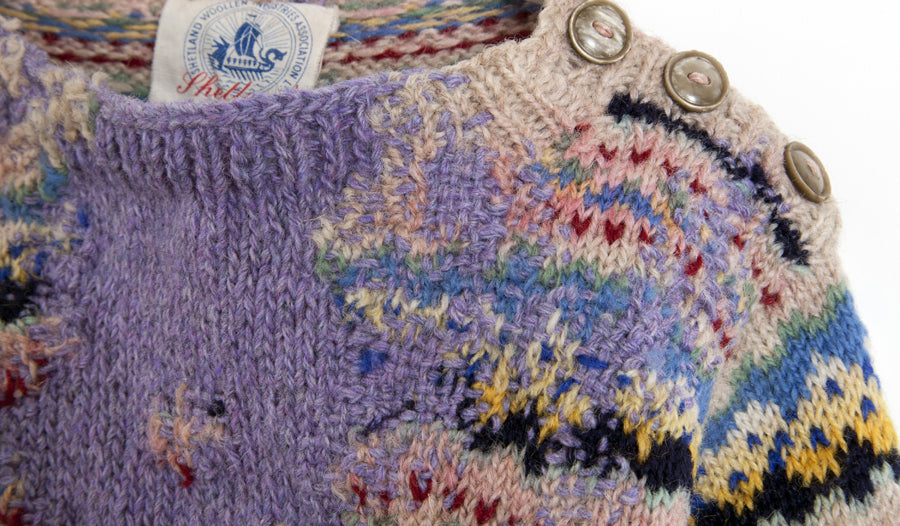
Why do we mend?
 Image: Celia Pym, Hope's sweater, 1951 (2010).
Image: Celia Pym, Hope's sweater, 1951 (2010).
We're continuing are discussion on the theme of mending by asking some of our Selvedge writers and contributors to tell us why they mend, and what repairing textiles and fabrics means to them. Explore more in our latest issue, Issue 102 Mend.
Kate Sekules - clothes historian, writer, mender
Why do you mend? What does repairing textiles/fabrics mean to you?
Mending to me is part of getting dressed, and getting dressed has little to do with fashion as we know it. Clothes and design are lively arts we have to find in the field, not from (most) shops and certainly not from out of the fashion industrial complex. Mending is also an art form—a scrappy one. It’s extemporizing with cloth and thread, a creative, personal process that’s way more than just repair. More and more of my clothes are mended, always extremely visibly, so that my relationship with what I wear is inextricable from my textile interventions, my fibre art practice. I call it “menditation”; it’s good for the soul. And actually, I believe clothes have little souls—they interact materially with their wearer and absorb life force over the years. We take this ordinary wardrobe magic for granted –the lucky socks, the results dress, the inexplicably favourite old t-shirt—but it should be honoured, and that’s what a loving bout of mending does.

Image: Celia Pym, Where Holes Happen, 2018 (detail).
I grew up mending, as a child of the “make do and mend” WWII generation, the last one to mend as a matter of course. Being immersed in the mending world, I’m biased, but I think it’s coming back, as more and more people understand the mess we’re in with our metastasized fashion industry. It’s insane to keep consuming. Creative interventions in the trillions of existing garments can keep us going for decades, and anything produced new should be considered and special: it should cost more and be an investment.
I am a dress historian focused on mending research—a very tiny specialization but one that is growing and spreading. I’m asked to guest lecture quite frequently these days, and that is a great privilege and a joy, to refocus the canonical hemline histories into “history from below”—the real lives of the majority of people. When you think about it, the history of mending simply is the history of clothes: we forget how incredibly valuable fabric always was, until not much more than a century ago, and how universal was the need to preserve the precious resource.

When I teach visible mending, my main aim is to enthuse, to enable anyone and everyone to participate and take control of their own wardrobe and relationship to fashion—and therefore to their deeper self. I’ve named a whole lot of techniques, and recalibrated stitch guides to be usable specifically for mending. People are intimidated by sewing, and think they can’t touch their own clothes, that they should be left to experts, like cars and iPhones. But once they start, people are delighted with the freedom offered by visible mending, the permission to play, and the ability to make mistakes and have that be OK; mistakes are often the best mends— like chefs discovering great recipes by accident. Visible mending is the Caesar Salad of fashion!
Celia Pym - artist
Why do you mend?
Darning is small acts of care and paying attention. The damage, in a way, does the work for me. I respond to it. The mending is slow work to hold the damage in place.
To find out more about Issue 102 Mend, visit the Selvedge website.

6 comments
I love this whole concept. I am a 50’s baby and was raised on sewing, knitting and needlework. Make do and mend was the backbone of my childhood zI n now still mending, making and upcyclying. Waste is not an option in this world as it is.
I am thrilled when my girls or granddaughters bring me something to mend or revise to be wearable again. I grew up one of 9 children, so mending and making do was a way of life. I love to sew, quilt and crochet so the girls know I can repair most anything. At least two of my daughters have taken up the needles and I’m hoping, that a few of the grands will follow along in time. It’s so satisfying to save a loved item to live a bit longer.
I am thrilled when my girls or granddaughters bring me something to mend or revise to be wearable again. I grew up one of 9 children, so mending and making do was a way of life. I love to sew, quilt and crochet so the girls know I can repair most anything. At least two of my daughters have taken up the needles and I’m hoping, that a few of the grands will follow along in time. It’s so satisfying to save a loved item to live a bit longer.
I mend because in our family, it was a way of life. Both of my parents were children of the Depression, poor, hardworking with many siblings. All their clothes were hand me downs. They grew their own food, fixed things that got broken, built whatever was needed from used materials. I learned to sew in utero. Am now 75 and although still enjoy repairing, altering, upscaling (or whatever the latest term is) clothing and books because it prevents waste. Our environment is affected by wasteful overmanufacture. I am a retired textile and clothing designer, so know the reality of how factories create and how they pollute.
I run make do and mend workshops in my community (the unfashionable part of East London) I expect more interest in visible mending in the next tranche- wonderful example Celia! I make bespoke clothes for a living, but I absolutely understand the need to consume less and that’s why I also mend, alter and upcycle as well as running workshops, to help local residents do the same.